Effects of Carbon Nanotubes on Thermal Behavior of Epoxy Resin Composites
Abstract
1. Introduction
2. Materials and Methods
2.1. Materials
2.2. Molding Manufacturing
2.2.1. Making Plexiglass Molds
2.2.2. Making Silicone Molds
2.3. Fabrication of Standard Samples
2.3.1. Pure Epoxy Resin
2.3.2. CNT Reinforced Epoxy
2.4. Dynamic Mechanical Thermal Analysis (DMTA)
2.5. Thermogravimetric Analysis (TGA)
3. Results and Discussion
3.1. Dynamic Mechanical Thermal Analysis (DMTA)
3.2. Thermal Gravimetric Analysis (TGA)
3.3. Density
4. Conclusions
- DMTA showed that the storage modulus, loss modulus, and tanδ values increased with the increase of wt.% CNTs. The storage modulus, the loss modulus, and the tanδ of the nanocomposite sample reinforced with 0.075 wt.% CNTs increased by 43.8%, 74.4%, and 696%, respectively, compared to the pure epoxy resin. The reason why the three parameters of dissipation modulus, storage modulus and tanδ all increase with the increase of the wt.% CNTs is the energy absorption property of the CNTs.
- TGA showed that the epoxy nanocomposites were thermally stable due to the addition of CNTs. The increase in the degradation temperature of the nanocomposites is due to the strong interactions between the epoxy matrix and the CNTs, which is caused by the thermal stability of the CNTs. The pure epoxy sample has the lowest degradation temperature. By adding 0.075 wt.% CNTs to the epoxy resin, the temperature corresponding to a 10% and 50% weight loss in the pure epoxy samples increased by 14 °C and 4.3 °C, respectively. According to the results of the DTGA, the degradation temperature of the nanocomposite samples reinforced with 0.075 wt.% CNTs increased by 9 °C.
- Density measurements showed that the density of the nanocomposite samples increased by adding CNTs to the pure epoxy resin. The ratio of the actual density to the theoretical density of the nanocomposite samples reinforced with 0.025, 0.05, and 0.075 wt.% CNTs are 0.925, 0.926 and 0.927, respectively.
- The well-dispersed CNTs in the epoxy resin can strongly affect the performance of the composites. Otherwise, the CNTs cannot significantly improve the performance of the resin.
- Since CNT-reinforced epoxy matrix composites can absorb more energy through heat and can be used to reduce heat loss and resist high temperatures, which is an optimal choice for designers and engineers who want to increase the effectiveness of their products.
Author Contributions
Funding
Data Availability Statement
Acknowledgments
Conflicts of Interest
References
- Silvia, R.; Antonio, N. Mechanical Characterization of Sandwich Structure Comprised of Glass Fiber Reinforced Core. In Proceedings of the Composites in Construction part 2, in 3rd International Conference—Composites in Construction 2005, Iyon, France, 11–13 July 2005. [Google Scholar]
- Jorio, D.G.; Dresselhaus, M.S.; Jorio, A. Carbon nanotubes advanced topics in the synthesis. In Structure, Properties and Applications; Springer: New York, NY, USA, 2008. [Google Scholar]
- Berber, S.; Kwon, Y.; Tomanek, D. Unusually high thermal conductivity of carbon nanotubes. Phsical. Rev. Lett. 2000, 84, 4613–4616. [Google Scholar] [CrossRef] [PubMed]
- Najmi, L.; Zebarjad, S.M.; Janghorban, K. Effects of Carbon Nanotubes on the Compressive and Flexural Strength and Microscopic Structure of Epoxy Honeycomb Sandwich Panels. Polym. Sci. Ser. B 2023, 65, 220–229. [Google Scholar] [CrossRef]
- Fatemi, J.; Lemmen, M.H.J. Effective Thermal/Mechanical Properties of Honeycomb Core Panels for Hot Structure Applications. J. Spacecr. Rocket. 2009, 46, 514–525. [Google Scholar] [CrossRef]
- Tahmasbi, V.; Noori, S. Thermal Analysis of Honeycomb Sandwich Panels as Substrate of Ablative Heat Shield. J. Thermophys. Heat Transf. 2017, 32, 1–12. [Google Scholar] [CrossRef]
- Kim, P.; Shi, L.; Majumdar, A.; McEuen, P.L. Thermal transport measurements of individual multiwalled nanotubes. Phys. Rev. Lett. 2001, 87, 215502. [Google Scholar] [CrossRef]
- Pop, E.; Mann, D.; Wang, Q.; Goodson, K.; Dai, H. Thermal conductance of an individual single-wall carbon nanotube above room temperature. Nano Lett. 2006, 6, 96–100. [Google Scholar] [CrossRef]
- Wang, S.; Qiu, J. Enhancing thermal conductivity of glass fiber/polymer composites through carbon nanotubes incorporation. Compos. Part B Eng. 2010, 41, 533–536. [Google Scholar] [CrossRef]
- Hashemi, S.A.; Mousavi, S.M. Effect of bubble based degradation on the physical properties of single wall carbon nanotube/epoxy resin composite and new approach in bubbles reduction. Compos. Part A Appl. Sci. Manuf. 2016, 90, 457–469. [Google Scholar] [CrossRef]
- Najmi, L.; Hu, Z. Review on Molecular Dynamics Simulations of Effects of Carbon Nanotubes (CNTs) on Electrical and Thermal Conductivities of CNT-Modified Polymeric Composites. J. Compos. Sci. 2023, 7, 165. [Google Scholar] [CrossRef]
- Kim, J.B.; Byun, J.H. Influence of the CNT length on complex permittivity of composite laminates and on radar absorber design in X-band. In Proceedings of the 10th IEEE International Conference on Nanotechnology, Ilsan, Korea, 17–20 August 2010; pp. 635–638. [Google Scholar]
- Loos, M.R.; CoelhoI, L.A.; Pezzini, S.H. Effect of carbon nanotubes addition on the mechanical and thermal properties of epoxy matrices. Mater. Res. 2008, 11, 347. [Google Scholar] [CrossRef]
- Caglayan, C.; Kim, G.; Yun, G.J. CNT-Reinforced Self-Healable Epoxy Dynamic Networks Based on Disulfide Bond Exchange. ACS Omega 2022, 7, 43480–43491. [Google Scholar] [CrossRef] [PubMed]
- Her, S.C.; Lin, K.Y. Dynamic mechanical analysis of carbon nanotube-reinforced nanocomposites. J. Appl. Biomater. Funct. Mater. 2017, 15, 13–18. [Google Scholar] [CrossRef] [PubMed]
- Burger, N.; Laachachi, A.; Ferriol, M.; Lutz, M.; Toniazzo, V. Review of thermal conductivity in composites: Mechanisms, parameters and theory. Prog. Polym. Sci. 2016, 61, 1–28. [Google Scholar] [CrossRef]
- Lee, D.K.; Yoo, J.; Kim, H.; Kang, B.H.; Park, S.H. Electrical and Thermal Properties of Carbon Nanotube Polymer Composites with Various Aspect Ratios. Materials 2022, 15, 1356. [Google Scholar] [PubMed]
- Karingamanna, J.; Nanoth, R.; Kumar, M.R. Thermal and Rheological Measurement Techniques for Nanomaterials Characterization. In Micro and Nano Technologies; Elsevier: Amsterdam, The Netherlands, 2017. [Google Scholar]
- Bhagyaraj, S.; Oluwafemi, O.S.; Kalarikkal, N.; Thomas, S. Characterization of Nanomaterials; Elsevier: Amsterdam, The Netherlands, 2018. [Google Scholar]
- Anirudh, S.; Caroline, P.; Mattiasson, B.J. Probing the eelationship between molecular structures, thermal transitions and morphology in polymer semiconductors using a woven glass-mesh based DMTA technique. Chem. Mater. 2019, 31, 6740–6749. [Google Scholar]
- Danoglidis, P.A.; Konsta-Gdoutos, M.S.; Gdoutos, E.E.; Shah, S.P. Strength, energy absorption capability and self-sensing properties of multifunctional carbon nanotube reinforced mortars. Constr. Build. Mater. 2016, 120, 265–274. [Google Scholar] [CrossRef]
- Saito, R.; Dresselhaus, G.; Dresselhaus, M.S. Physical Properties of Carbon Nanotubes; Imperial College Press: Tokyo, Japan, 1998. [Google Scholar]
- Chalal, S.; Haddadine, N.; Bouslah, N.; Souilah, S.; Benaboura, A.; Barille, R.; Haroun, A. Preparation characterization and thermal behaviour of carbopol-TiO2 nanocomposites. Open J. Org. Polym. Mater. 2014, 4, 55–64. [Google Scholar] [CrossRef][Green Version]
- Xu, F.; Sun, L.; Zhang, J.; Qi, Y.; Yang, L.; Ru, H.; Wang, C.; Meng, X.; Lan, X.; Jiao, Q.; et al. Thermal stability of carbon nanotubes. J. Therm. Anal. Calorim. 2010, 102, 785–791. [Google Scholar]
- Han, Z.H.; Fina, A. Thermal conductivity of carbon nanotubes and their polymer nanocomposites. Prog. Polym. Sci. 2011, 36, 914–944. [Google Scholar]
- Cetin, M.E. Improvement of the structural, thermal, and mechanical properties of polyurethane adhesives with nanoparticles and their application to Al/Al honeycomb sandwich panels. Mater. Test. 2022, 64, 272–283. [Google Scholar] [CrossRef]
- Nejad, S.M.; Srivastava, R.; Bellussi, F.M.; Thielemann, H.N.C.; Fasano, P.A.M. Nanoscale thermal properties of carbon nanotubes/epoxy composites by atomistic simulations. Int. J. Therm. Sci. 2021, 159, 106588. [Google Scholar] [CrossRef]
- Bajpai, R.; Davidson, J.R.; Robert, C. Studies on the Modification of Commercial Bisphenol-A-Based Epoxy Resin Using Different Multifunctional Epoxy Systems. Appl. Mech. 2021, 2, 419–430. [Google Scholar] [CrossRef]
- Omidi, M.J.; Shayan Mehr, M. Improving the dispersion of SWNT in epoxy resin through a simple Multi-Stage method. J. King Saud Univ. 2019, 31, 202–208. [Google Scholar] [CrossRef]
- Sharma, S.C. Equation for the density of particle-reinforced metal matrix composites: A new approach. J. Mater. Eng. Perform. 2003, 12, 324–330. [Google Scholar] [CrossRef]
- Tuwair, H.; Hopkins, M.; Volz, J.; ElGawady, M.A.; Mohamed, M.; Chandrashekhara, K.; Birman, V. Evaluation of sandwich panels with various polyurethane foam-cores and ribs. Compos. Part B Eng. 2015, 79, 256–276. [Google Scholar] [CrossRef]
- Allen, H.G. Analysis and Design of Structural Sandwich Panels; Oxford: New York, NY, USA, 1969. [Google Scholar]
- Murata, H. Theory and Application to Biomaterials. In Polymerization; InTech: Nagasaki, Japan, 2012. [Google Scholar]
- Sperling, L.H. Sound and Vibration Damping with Polymers. In Basic Viscoelastic Definitions and Concepts; American Chemical Society: Washington, DC, USA, 1990. [Google Scholar]
- Leite, M.; Silva, A.; Freitas, M. Elastic behaviour of sandwich beams part 2: Numerical study. In Proceedings of the 9th Portuguese Conference on Fracture, Setubal, Portugal, 18–20 February 2004. [Google Scholar]
- Zebarjad, S.M.; Moghim, M.H. An Introduction to Polymer Nanocomposites; Mashhad: Ferdowsi, Iran, 2015. [Google Scholar]
- Ji, L.; Stevens, M.M.; Zhu, Y.; Gong, Q.; Wu, J.; Liang, J. Preparation and properties of multi-walled carbon nanotube/carbon/polystyrene composites. Carbon 2009, 47, 2733–2741. [Google Scholar] [CrossRef]
- Biercuk, M.J.; Llaguno, M.C.; Radosavijevic, M.; Hyun, J.K.; Johnson, A.T.; Fischer, J.E. Carbon nanotube composites for thermal management. Appl. Phys. Lett. 2002, 80, 2767–2769. [Google Scholar]
- Du, F.; Guthy, C.; Kashiwagi, T.; Fischer, J.E. An infiltration method for preparing single-wall nanotube/epoxy composites with improved thermal conductivity. J. Polym. Sci. Part B Polym. Phys. 2006, 44, 1513–1519. [Google Scholar] [CrossRef]
- Ciecierska, E.; Boczkowska, A.; Kurzydlowski, K.J.; Rosca, L.D.; Hoa, S.V. The effect of carbon nanotubes on epoxy matrix nanocomposites. J. Therm. Anal. Calorim. 2013, 111, 1019–1024. [Google Scholar] [CrossRef]
- Martin, C.A.; Sandler, J.K.W.; Shaffer, M.S.P.; Schwarz, M.-K.; Bauhofer, W.; Schulte, K.; Windle, A.H. Formation of percolating networks in multi-wall carbon-nanotube–epoxy composites. Compos. Sci. Technol. 2004, 64, 2309–2316. [Google Scholar] [CrossRef]
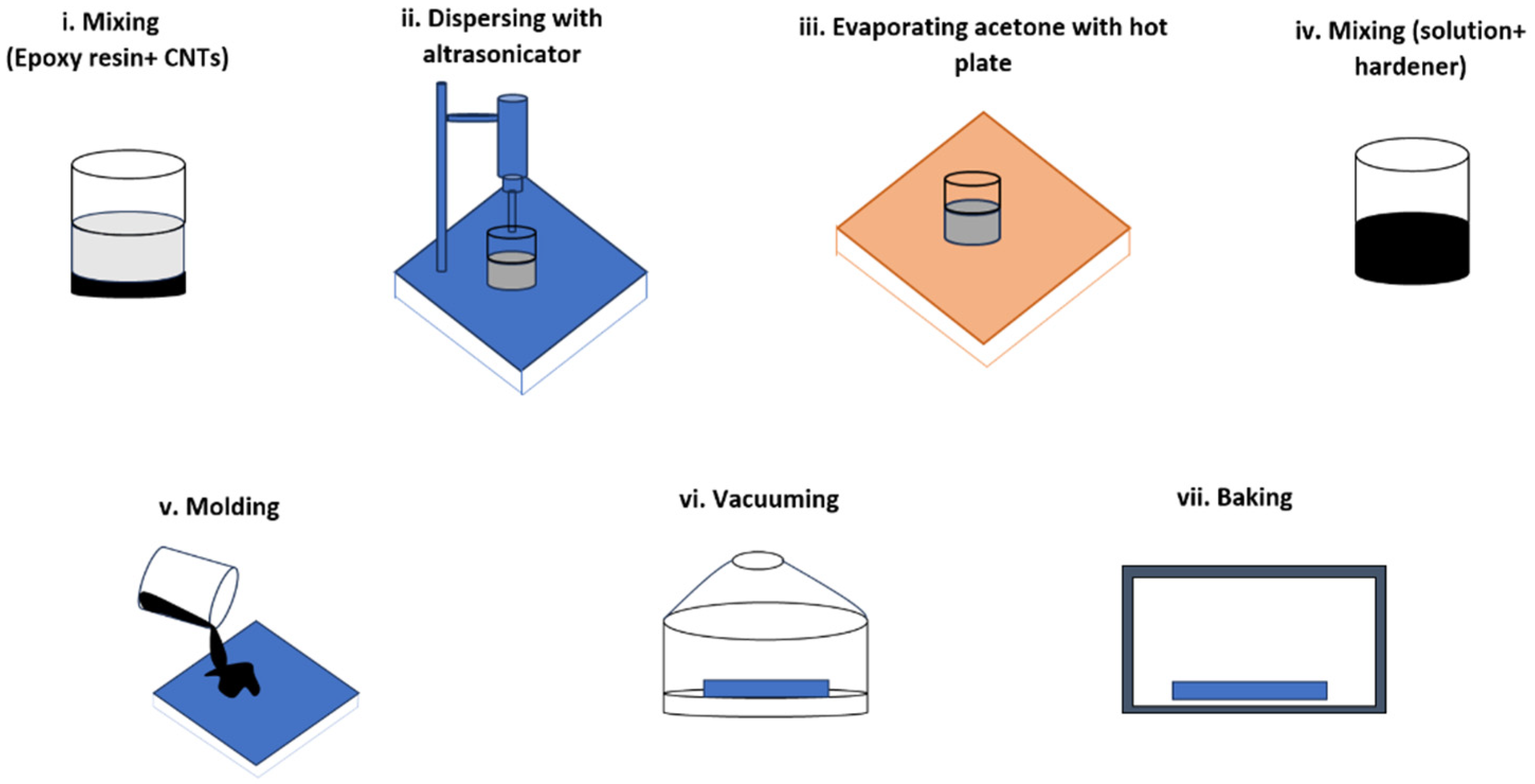
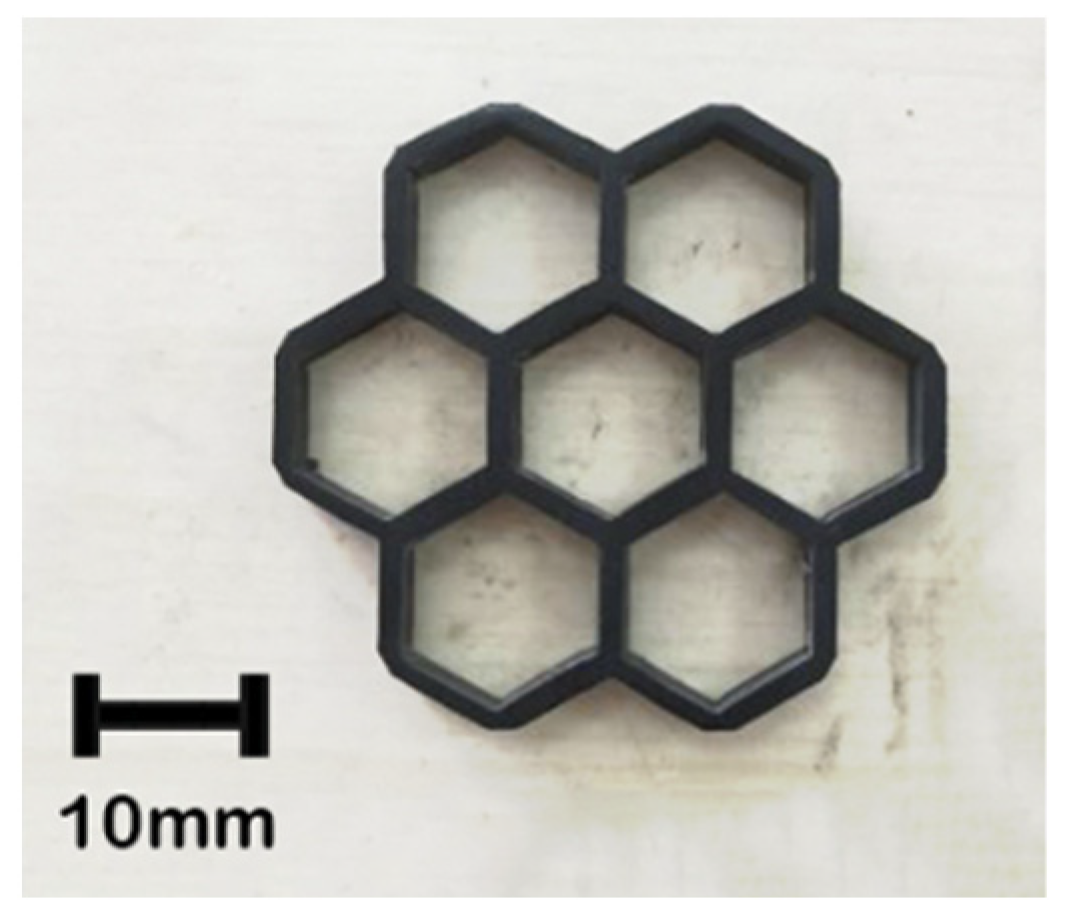
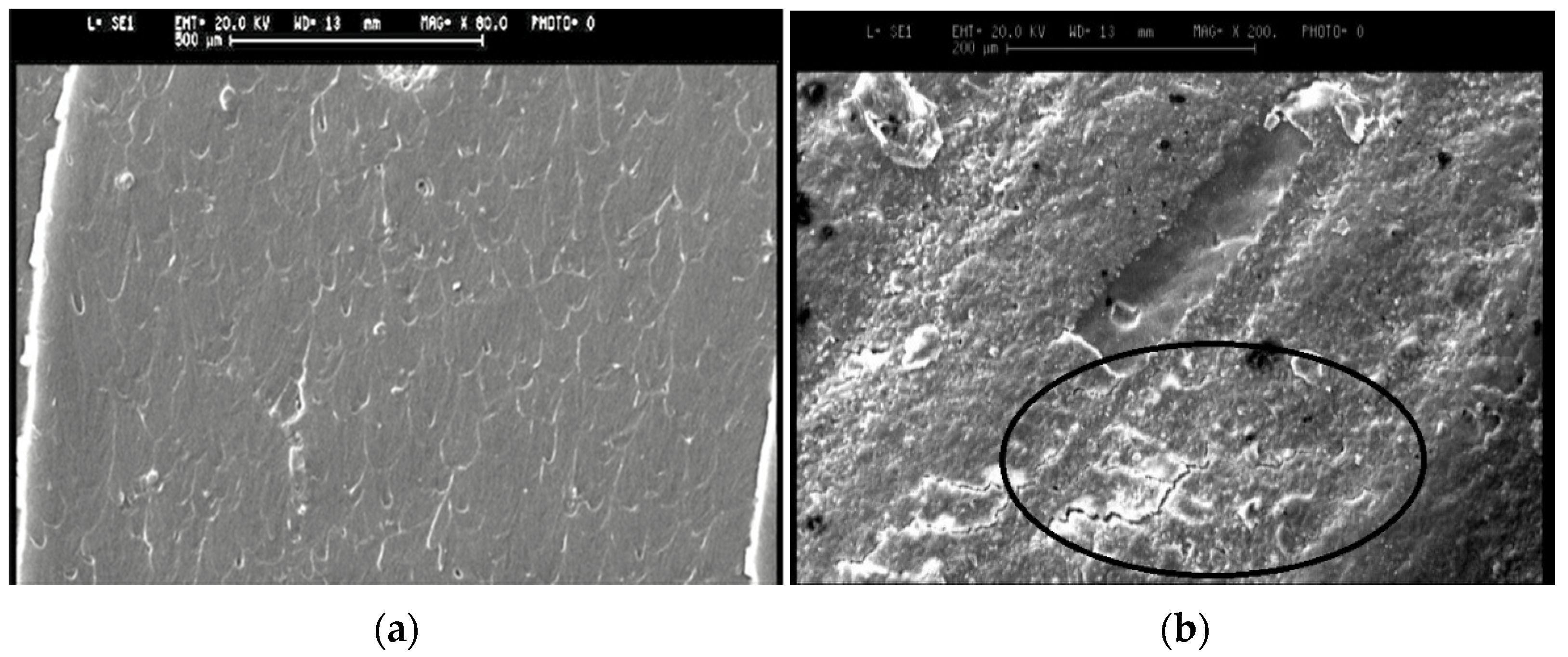
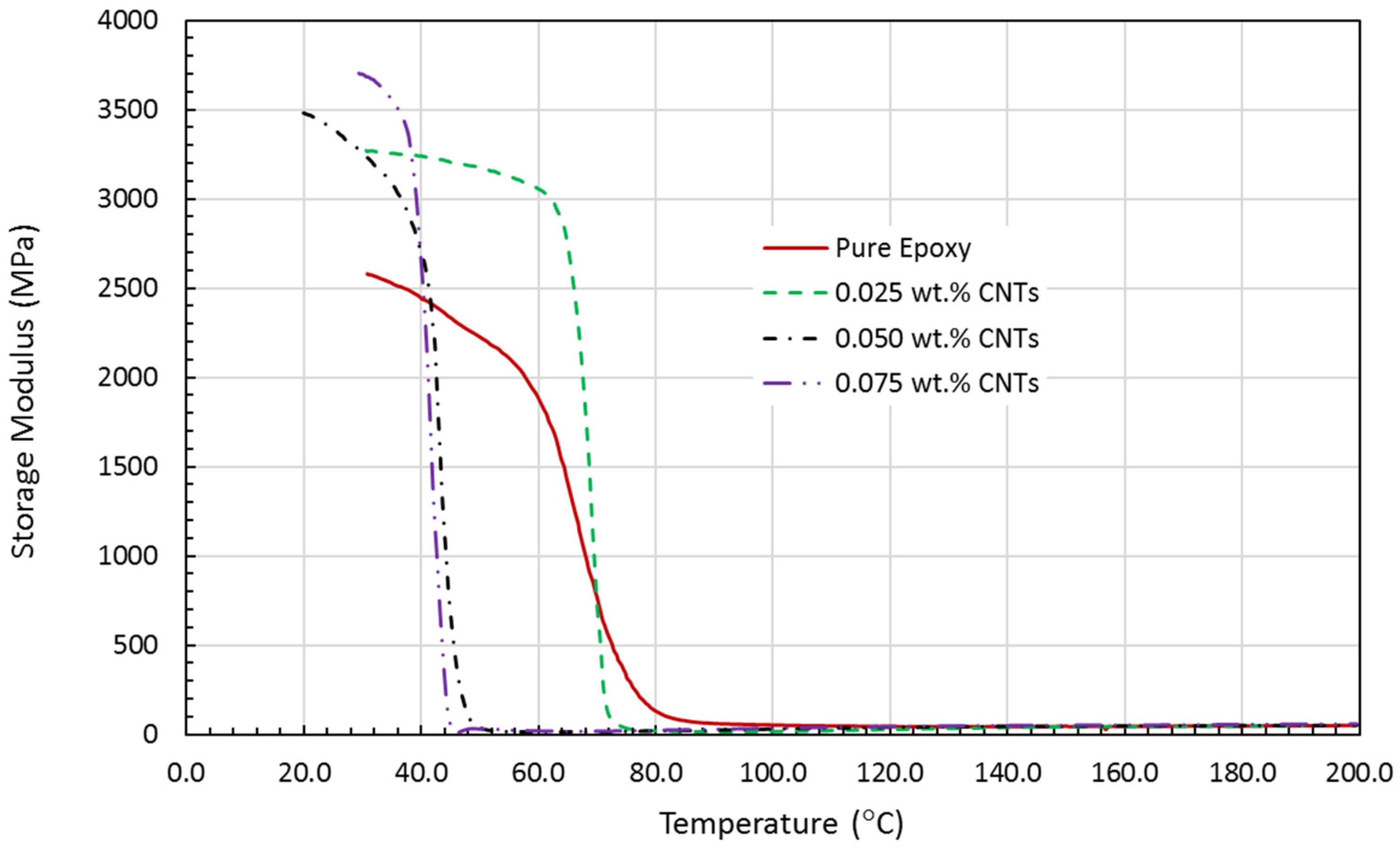
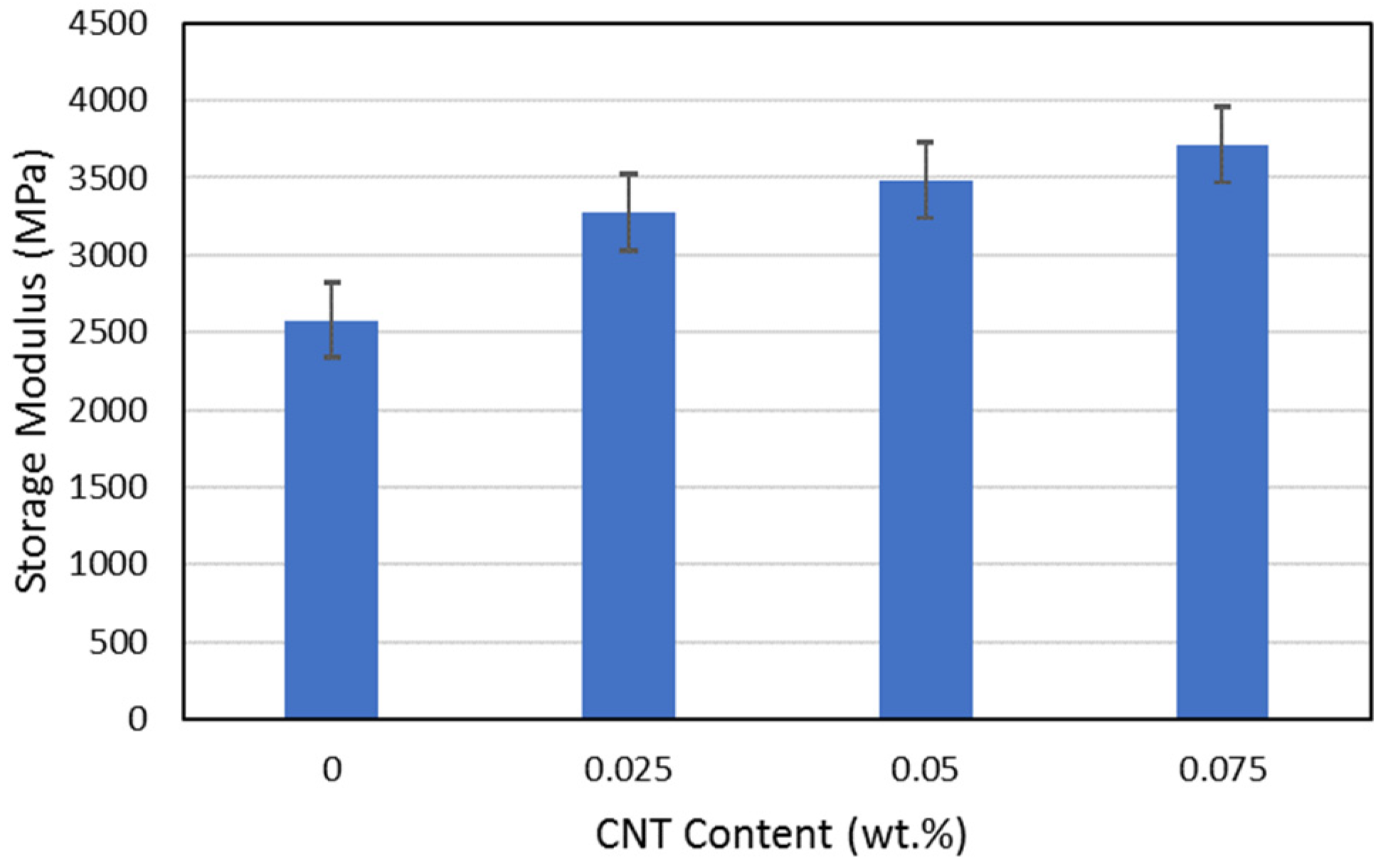
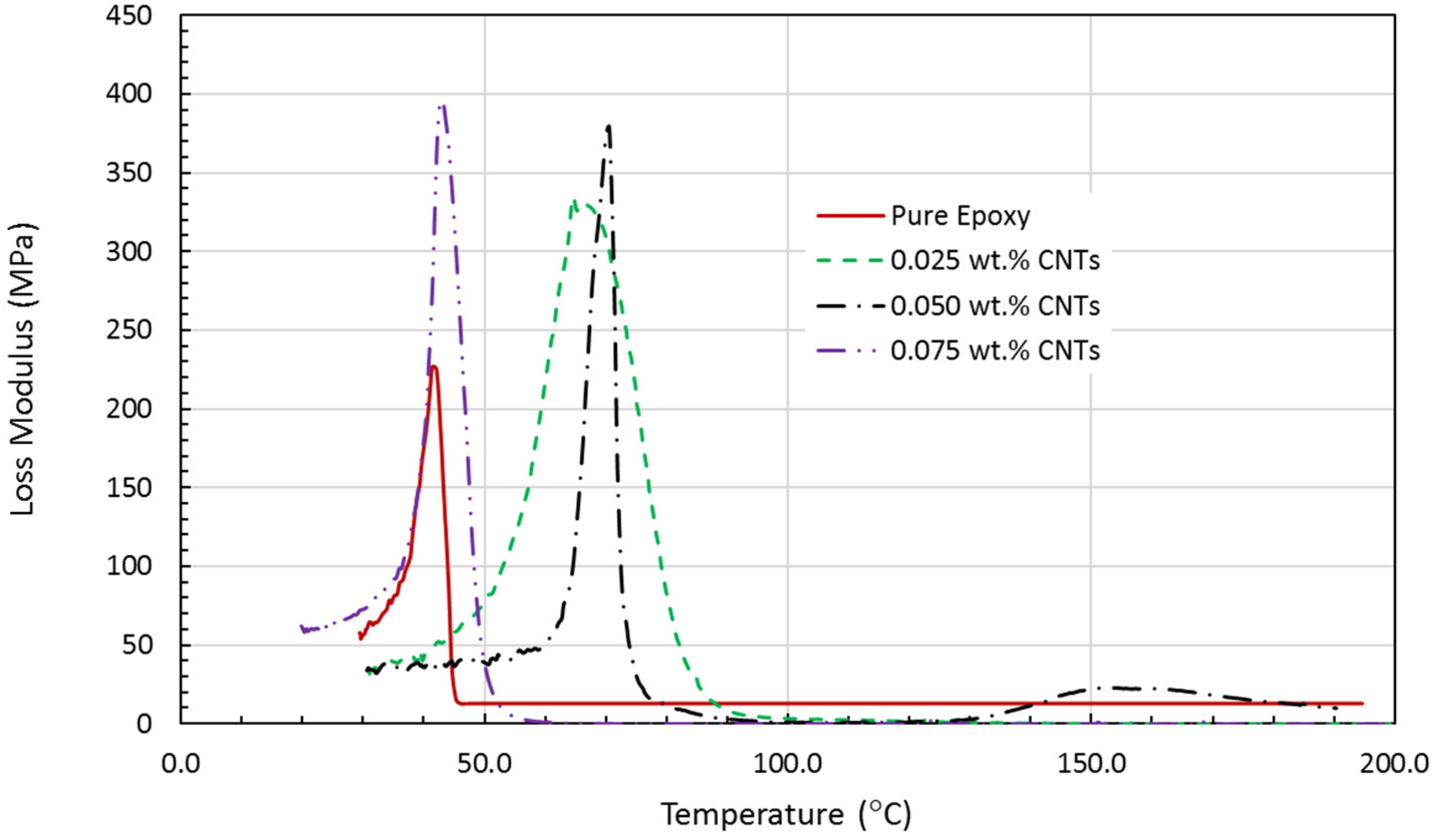


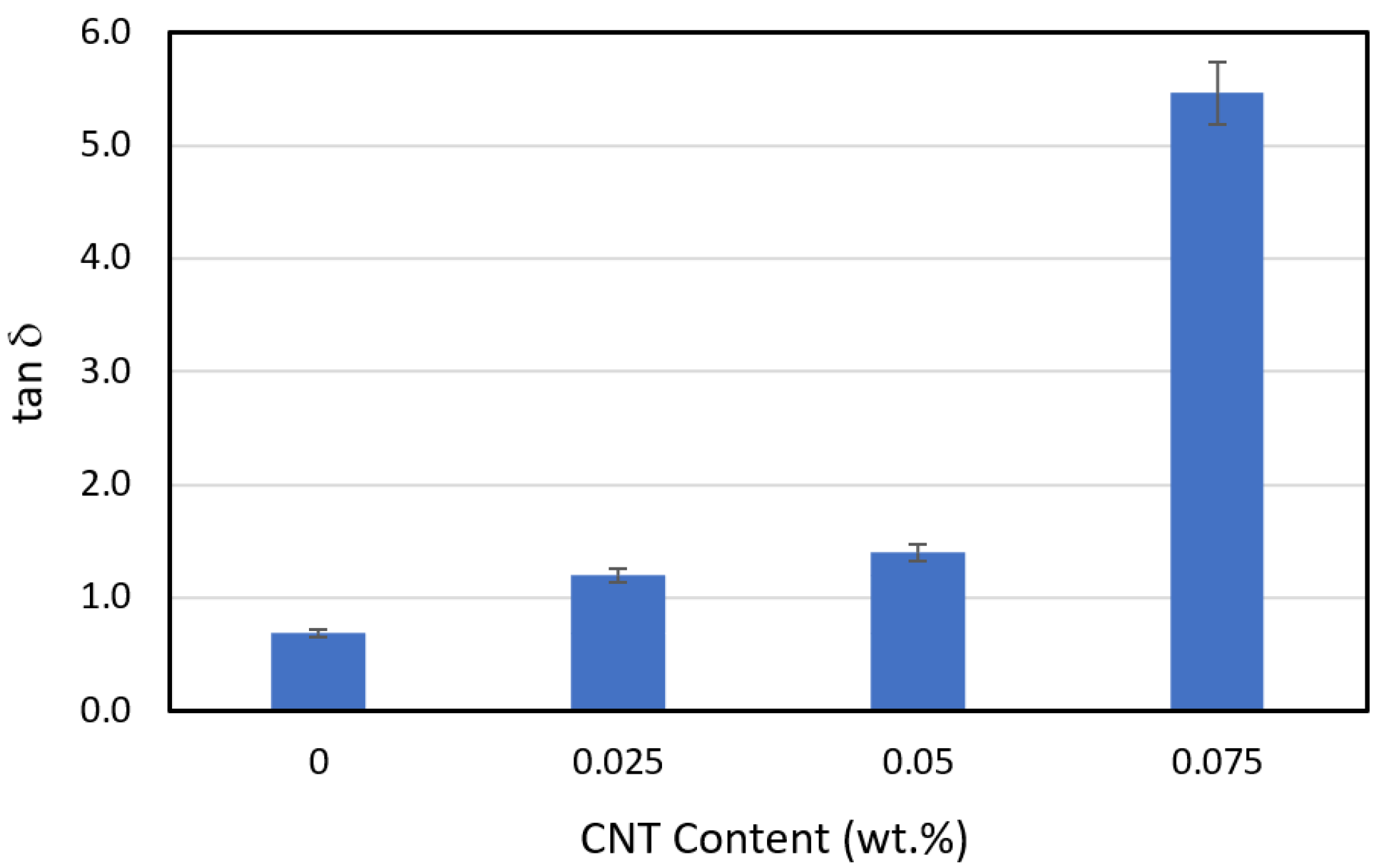



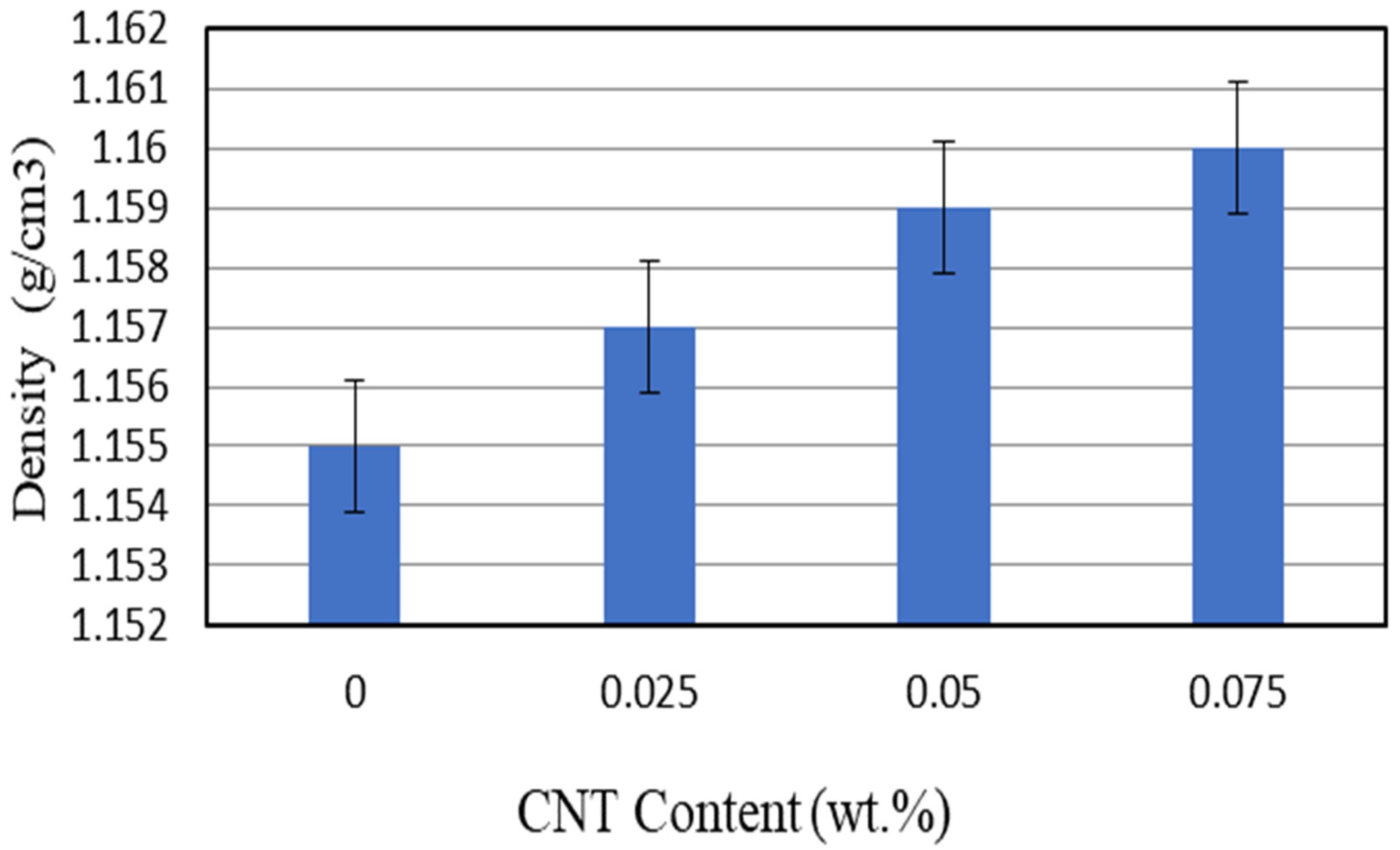
| Diameter | 20–30 nm |
| Length | 30 μm |
| Functional Group | Carboxyl (COOH) |
| Purity | >95 wt.% |
| Impurity | <1.5 wt.% |
| Sample | Tmax (°C) |
|---|---|
| Pure Epoxy | 355 |
| Epoxy + 0.025% CNT | 362 |
| Epoxy + 0.05% CNT | 363 |
| Epoxy + 0.075% CNT | 364 |
| Sample | T10 (°C) | T50 (°C) |
|---|---|---|
| Pure Epoxy | 8.333 | 372.3 |
| Epoxy + 0.025% CNT | 2.345 | 372.5 |
| Epoxy + 0.05% CNT | 4.346 | 376.1 |
| Epoxy + 0.075% CNT | 8.347 | 376.6 |
Disclaimer/Publisher’s Note: The statements, opinions and data contained in all publications are solely those of the individual author(s) and contributor(s) and not of MDPI and/or the editor(s). MDPI and/or the editor(s) disclaim responsibility for any injury to people or property resulting from any ideas, methods, instructions or products referred to in the content. |
© 2023 by the authors. Licensee MDPI, Basel, Switzerland. This article is an open access article distributed under the terms and conditions of the Creative Commons Attribution (CC BY) license (https://creativecommons.org/licenses/by/4.0/).
Share and Cite
Najmi, L.; Hu, Z. Effects of Carbon Nanotubes on Thermal Behavior of Epoxy Resin Composites. J. Compos. Sci. 2023, 7, 313. https://doi.org/10.3390/jcs7080313
Najmi L, Hu Z. Effects of Carbon Nanotubes on Thermal Behavior of Epoxy Resin Composites. Journal of Composites Science. 2023; 7(8):313. https://doi.org/10.3390/jcs7080313
Chicago/Turabian StyleNajmi, Lida, and Zhong Hu. 2023. "Effects of Carbon Nanotubes on Thermal Behavior of Epoxy Resin Composites" Journal of Composites Science 7, no. 8: 313. https://doi.org/10.3390/jcs7080313
APA StyleNajmi, L., & Hu, Z. (2023). Effects of Carbon Nanotubes on Thermal Behavior of Epoxy Resin Composites. Journal of Composites Science, 7(8), 313. https://doi.org/10.3390/jcs7080313








